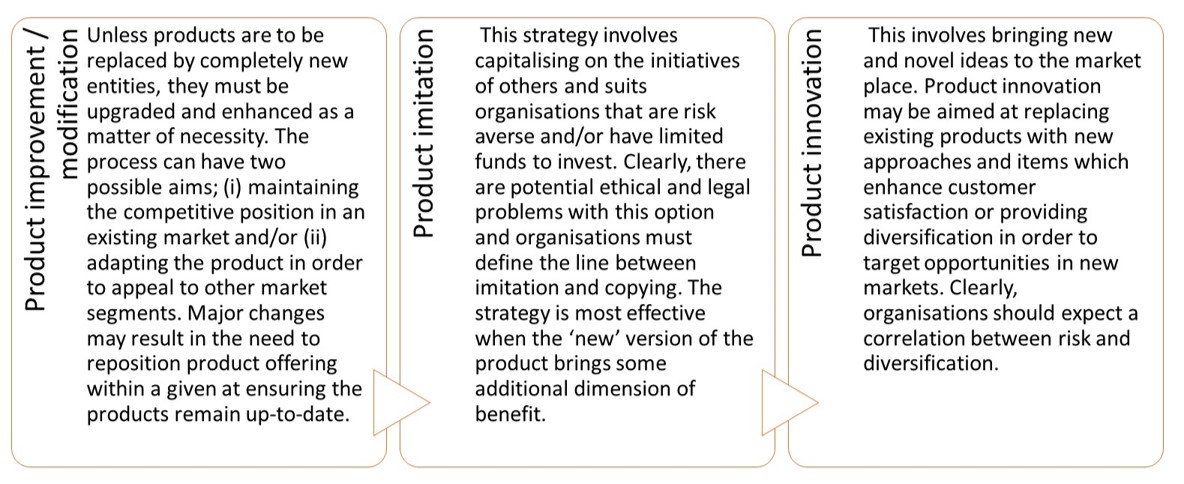
It is essential that all organisations develop products. Product development and innovation are the ‘life blood’ of any business. By definition, development and innovation are strategic activities that shape the future. The creation of an acceptable product offering involves many strategic decisions.
Kotler defines a product as having three levels. Firstly, a core product defines the fundamental need being meet. Fundamental needs are generic in nature (e.g. transportation, data storage or self-esteem).
Secondly, the actual product is the specific offering aimed at meeting a core need. This includes attributes such as styling, branding, performance features and packaging. Finally, the augmented product, which enhances the actual product by offering additional services and benefits, making the product a more attractive proposition to the consumer. Examples include factors such as after-sales support, maintenance and affordable finance.
Fundamentally, a product delivers a set of benefits to a customer, in order to meet a need. Organisations must strive to fully understand this process and be certain their product offering best matches not only need, but also customer expectation.
Product Development Strategy
There is much debate relating to product development strategies. For example, how is the term ‘new product’ defined? The reality is that few products are ‘new in the sense of being innovative, unique or novel. Most ‘new’ products are updates and revamp of existing goods and services. Jain views new product strategy in terms of three categories.

Managing Innovation
Organisations cannot remain focused on the past. The static organisation that believes the ‘old ways are the best’ will flounder. Innovation means change. Such changes are not normally single events, but are complex combinations of actions and functional activity. Note: innovation and invention are not one and the same, as innovation is concerned with the commercial application of ideas.
Senior management should address the issue of innovation and create a culture and infrastructure to support the process. After all, organisations that continue to learn and effectively translate this learning into product offerings are the ones who will prosper. Innovation creates the environment for successful product development. Product improvement and modification, product imitation and product innovation (where the product is truly new or novel – all stem from the overall process of innovation.
Click here to view a video that explains product development
Strategic Alliances and Relationships
Alliances
Managers at strategic level aim to ‘add value’ by ensuring the organisation has the optimal level of assets and competencies. Strategic thinking increasingly recognise that it is neither wise, nor feasible, to attempt to exclusively provide/own this optimal level of assets and competencies. Rather than do everything ourselves, it may be more feasible to enter into partnership arrangements with other organisations. For example, two manufacturers could set up a joint distribution system and both benefit from economies-of-scale.
Relationship Marketing
The concept of relationship marketing takes marketing back to basic principles. It recognises the fundamental importance of sustaining customer relationships in order to generate customer loyalty and repeat business. Additionally, relationship marketing acknowledges a broader view of marketing, and defines a number of ‘markets’ which must be addressed in order to optimise customer relationships. Undoubtedly, customer markets should be the primary focus of any organisation. Previously, marketing has tended to focus on finding new customer and winning new business. Modern marketing practice (relationship marketing) now recognises the importance of retaining customers and generating repeat business. Relationship approaches aim to develop customer alliances, whereby the customer not only sees the organisation as their preferred provider, but actively recommends others to use their products and services. This ‘elevated status’ is more achievable when a broader view of marketing is taken. Such a view recognises the role of ‘markets’, other than the direct customer, in developing customer relationships.
Developing Relationships
There is a strong body of evidence supporting the economic case for relationship marketing. For example, Reichheld and Sasser (1990) illustrate that relatively minor improvements in customer defections can generate significant improvements in profit. As relationships are built on mutual benefit, what benefits does relationship marketing bring to customers? The approach typically benefits customers as follows:
(i) requires marketers to have a much closer understanding of customer needs and therefore provide more appropriate solutions to customer problems,
(ii) may result in schemes rewarding customer loyalty, and
(iii) fuses together all aspects of the business, making the entire entity more customer focused and responsive to customer need.
Click here to view a video that explains strategic alliances.